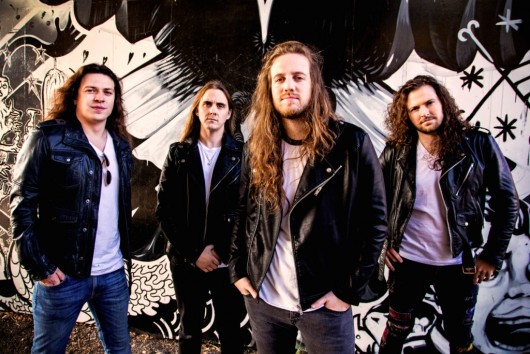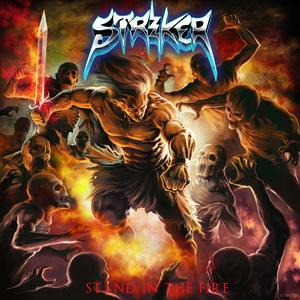Striker skewers status quo
Posted on January 19, 2016 By Mike Ross Entertainment, Front Slider, Music, music
 In the verdantly-bearded acoustic guitar-strumming Edmonton indie music scene, Striker sticks out like a sore thumb.
In the verdantly-bearded acoustic guitar-strumming Edmonton indie music scene, Striker sticks out like a sore thumb.
“I sure hope so!” says guitarist Tim Brown. “We’re trying to do own thing,” he explains, “and the big thing about that is just love. We love what we’re doing, and so it’s authentic. I think people are starting to respond to that.”
He allows that part of the reason his popular hair-metal band won the recent $8,000 Edmonton Music Prize may be that there are simply no other local bands like Striker. They split the hipster vote. Eight grand will buy a lot of hair spray.
Brown chuckles weakly at the joke, as if he’s heard it before. No matter how you try to avoid it, hair will always rear its head when you talk about music. It’s right there, staring you in the face. We call Striker “hair metal” because their music owes so much to the hair metal heroes of the past. Metal dudes of more modern style – death, black, extreme, etc – sport long hair, too, but genuine hair metal is neatly combed: slick, produced, guitars distorted but perfectly in tune; the chord changes are layered in sweet consonance; the vocals are high and also perfectly in tune, not all doom like the death metal dudes. If Striker stepped out of a time machine in the year 1986, no one would give them a second thought amongst all the Poisons, Ratts and Defs Leppards. Thirty years later, Striker is a freak of nature.
 That suits them just fine.
That suits them just fine.
“We’ve stuck to our guns,” says Brown. The band celebrates the release of its latest album, Stand in the Fire, at the Starlite Room on Friday. Hair metal has rarely sounded better. Consider it a strengthening of the brand. From home, it’s off to Europe, Mexico, South America and the United States by spring – an elaborate tour Brown says took almost a year to wrangle. Metal bands these days tend to belong to a global community rather than whatever music scene they happen to be from. Striker’s new album was produced and released on their own, too, which technically makes them an “indie” band.
“I remember I started playing this style of music 10 years ago and back then there was absolutely no one doing it,” Brown says. “I step out there with spandex pants, jumping around, singing lots of high notes, and people look at you kind of funny, but at the same time I think the biggest thing that matters is if you put a good show and have good music, then the rest of that stuff doesn’t matter.”
Striker is well aware of the Retro Trap.
“We like the ‘80s influence a lot, and there’s this new wave of traditional heavy metal people are talking about,” he says. “A lot of those bands, at least to us, are more of a regressive kind of band, like, oh, this sounds like a Judas Priest song. If I wanted to listen to Judas Priest, I’d listen to Judas Priest. I’m sure we’re guilty of that too, but we really wanted to put other influences in with our old influences, branching out.”
Metal bands of any subgenre are often snubbed come awards or grant funding time, Brown complains, but these guys have made a nice stab towards changing the stigma. Striker is just too good to ignore any longer.













